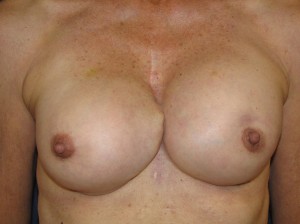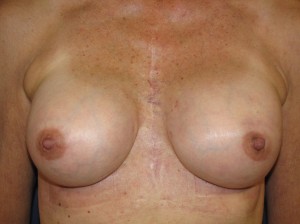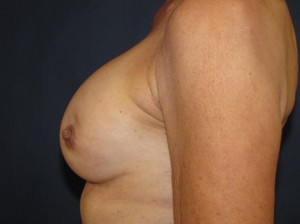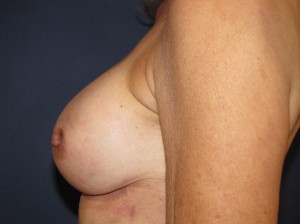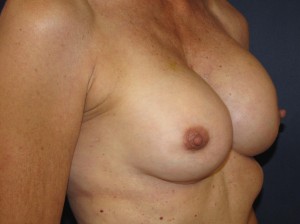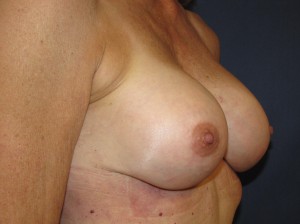Whether inserting implants for a breast augmentation or in breast reconstruction, the outcome is not always what was expected or desired. One such unplanned result is where the breast implants are so close together that they form a “uniboob” which is technically known as symmastia. A variant is where the implant on one side crosses the midline of the chest and extends to the other side. In my post of Dec. 14, 2009 (Etiology of Symmastia aka the Uniboob Following Breast Enlargement), I explore symmastia issue in some detail.
Though occurring far more commonly as a result of breast augmentation surgery, this condition can also manifest itself with breast reconstruction. It is not a rare problem but it can be quite challenging requiring very tedious and intricate techniques to correct. With the advent of AlloDerm®, Strattice® and other tissue matrix (dermal graft) options, the treatment can potentially be more predictable, desirable and permanent.
The following case of mine illustrates an example of a symmastia variant that was successfully treated with this approach. This is a 60 year old female who underwent an implant exchange a few years ago, replacing those which had been present from her breast augmentation performed 30 years. The symmastia occurred following this most recent procedure. She was very unhappy with the deformed appearance, contour irregularities, the substantial asymmetries, rippling of the skin which had developed and the limitations that she had in wearing many styles of clothes (photos A, C, and E). Notice the right breast with the implant extending well over to the left side and the associated irregular contour. The left implant is also significantly higher than the right.
Her breast revision and symmastia surgery consisted of exchanging her large broad implants for more projecting high profile implants that were smaller in volume and precisely placed. Contouring and repositioning of the tissues were performed and AlloDerm® tissue matrix graft was employed to meticulously secure and configure the breast implant placement.
The results shown just 7 weeks following the reconstructive surgery illustrate the substantial improvement in her breast positioning, contour and projection with resolution of the rippling that she was experiencing (photos B, D and F). Needless to say, she was quite satisfied with the outcome.
If you would like additional information on symmastia and its treatment, on breast augmentation, breast reconstruction or any other plastic surgery procedure or to schedule a consultation, please call my office at 480-451-3000.
Steven H. Turkeltaub, M.D. P.C.
Scottsdale and Phoenix, Arizona

